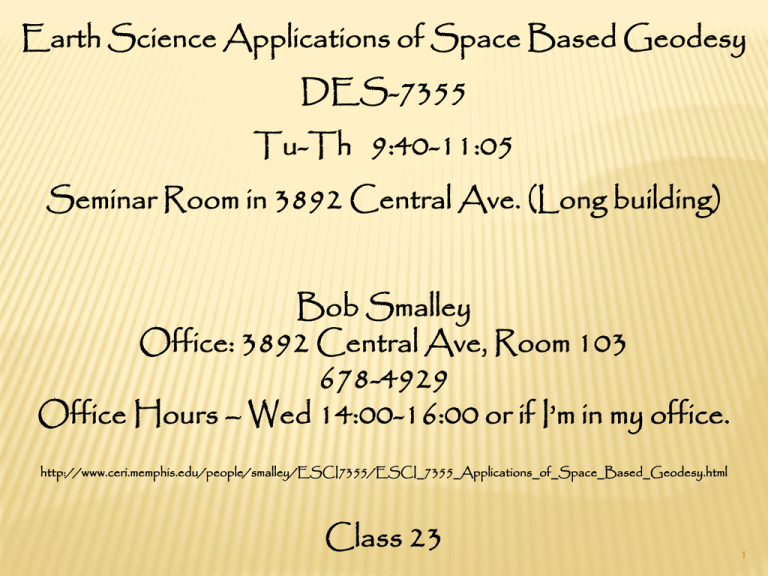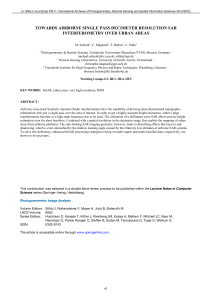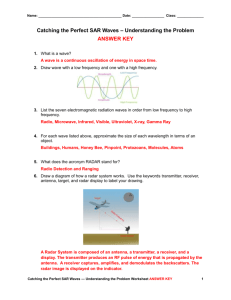class 23 pptx
advertisement

Earth Science Applications of Space Based Geodesy DES-7355 Tu-Th 9:40-11:05 Seminar Room in 3892 Central Ave. (Long building) Bob Smalley Office: 3892 Central Ave, Room 103 678-4929 Office Hours – Wed 14:00-16:00 or if I’m in my office. http://www.ceri.memphis.edu/people/smalley/ESCI7355/ESCI_7355_Applications_of_Space_Based_Geodesy.html Class 23 1 IMAGING RADAR - GENERAL RADAR = RAdio Detection and Ranging Uses the microwave region of the electromagnetic spectrum. Wavelengths used in imaging radar range between 1 mm and 1 m Longer wavelengths are used for communication and navigation. Murchison MICROWAVE REGION Murchison RADAR BANDS Wavelength Range and Descriptions Ka, K, and Ku Bands very short wavelengths used in early airborne radar systems but uncommon today used extensively on airborne systems for military reconnaissance and terrain mapping. X-band C-band S-band used on board the Russian ALMAZ satellite. L-band on many airborne research systems (CCRS Convair-580 and NASA AirSAR) and spaceborne systems (including ERS-1 and 2 and RADARSAT). used onboard American SEASAT and Japanese JERS-1 satellites and NASA airborne system. P-band Murchison longest radar wavelengths, used on NASA experimental airborne research system RADAR BANDS Murchison IMAGING RADAR ADVANTAGES Active system (works day or night). There is also passive microwave imaging (radiometer) mode. This senses surface radio-emission, which can be converted to radiant temperatures. Not affected by cloud cover or haze if l > 2 cm. It operates independent of weather conditions. Water clouds have a significant effect on radar with wavelength l < 2 cm. Unaffected by rain l > 4 cm. Can penetrate well-sorted dry sand in hyper-arid regions to a depth of about 2 m. Murchison TERMINOLOGY RAR: Real Aperture Radar SAR: Synthetic Aperture Radar SLAR: Side-looking airborne radar (could be RAR or SAR). SIR: Shuttle imaging radar (a SAR) 3 missions: SIR-A (1981), SIR-B (1984) and SIR-C (1994) INSAR: Interfereometric SAR. Can be satellite or airborne. SRTM: Shuttle Radar Topography Mission (an INSAR mapping mission) Murchison Synthetic Aperture Radar – Systems and Signal Processing APERTURE Optics : Diameter of the lens or mirror. The larger the aperture, the more light a telescope collects. Greater detail and image clarity will be apparent as aperture increases. 2.4m Hubble Space Telescope 10m Keck, Hawaii 16.4m VLT (Very Large Telescope), Chile 50m Euro50 100m OWL (OverWhelmingly Large T.) 이훈열 OVERWHELMINGLY LARGE TELESCOPE 이훈열 What is InSAR? • Method using an orbiting satellite that emits and receives radio energy in the form of waves •Carries two types of information. • Information about surface from which radio waves reflected carried in strength and intensity of signal •Changes in roundtrip distance seen through phase changes of the radio waves. Pablo, Mattioli,Jansma Synthetic Aperture Radar – Systems and Signal Processing REAL APERTURE VS. SYNTHETIC APERTURE • Real Aperture : resolution ~ Rλ/L • Synthetic Aperture: resolution ~ L/2 Irrespective of R Smaller, better?! - Carl Wiley (1951) 이훈열 IMAGE ACQUISITION ERS–1/2 SAR L: 10 m, D: 1 m Altitude: 785 km, sun-synchronous orbit Ground Velocity: 6.6 km/s Look Angle: Right 17-23 (20.355 mid-swath) Slant Range: 845 km (mid-swath) Frequency: C- Band (5.3GHz, 5.6 cm) Footprint : 100 km x 5 km Incidence Angle: 19 – 26 (23 mid-swath) Sampling Rate: 18.96 MHz Pulse duration: 37.1 s Range gate: ~ 6000 s Sampling Duration: ~ 300 s (5616 samples) Inter-pulse period: ~ 600 s ( upto 10 pulses) Pulse Repetition Frequency: 1700 Hz Data Rate: 105 Mb/s (5 bits/sample) 이훈열 SAR SYSTEMS Spaceborne SAR SEASAT-A (USA, 1978), SIR-A (USA, 1981), SIR-B (USA, 1984), SIR-C/XSAR (USA, Germany, Italy, 1994), ALMAZ-1 (Russia, 1991-1993), ERS-1(EU, 19912000), ERS-2 (EU, 1995-), JERS-1 (Japan, 1992-1998), Radarsat-1 (Canada, 1995-), SRTM (USA/Germany, 2000), ENVISAT (EU, 2002), RADARSAT-2 (Canada, 2005), PALSAR (Japan, 2004), LightSAR (US)*, TerraSAR (Germany)*, MicroSAR(EU)* Airborne SAR TOPSAR (JPL, USA), IFSARE(ERIM/Intermap, USA), DOSAR(Donier,Germany), E-SAR(DLR, Germany), AeS-1(Aerosensing, Germany), AERII (FGAN, Germany), C/X-SAR (CCRS, Canada), EMISAR (Denmark), Ramses (ONERA, France), ESR (DERA, UK) Planetary SAR Magellan (US, 1990-1994), Titan Radar Mapper (US, 2004), Arecibo Antenna, Goldstone antenna 이훈열 * Under development SAR SYSTEM MODES 이훈열 Target – the Earth or planets Vehicle – stationary, airborne, satellite, or spaceship Mode – monostatic and/or bistatic Carrier frequency – X, C, S, L, and/or P bands Polarisation – HH, VV, VH, HV (single-pol, dual-pol, full-pol) Imaging geometry – strip, scan, spot <examples> SIR-C/X-SAR: space shuttle, mono, L/C/X, full-pol. ERS-1/2, Envisat: Earth satellite, mono, C, VV. SRTM: space shuttle, mono/bistatic, C/X, HH/VV. Arecibo Antenna: planetary, stationary, mono/bi, multi-bands, multi-pol. Magellan, Cassini SAR: Venus and Titan, mono, S, HH. AIRSAR/TOPSAR: airborne, mono/bi, L/C/P, full-pol RANGE COMPRESSION Linear Chirp Signal Chirp autocorrelation Function f (t ) exp[ 2i( f 0 0.5at )t ], 0 t T Matched Filtering For ERS-1/2, Pulse duration (T): 37.1 s Bandwidth : 15.5 MHz Half power width of autocorrelation function: 0.065 s Pulse Compression Ratio: 575 (ERS-1/2) Ground Range Resolution: 12.5 m Input 이훈열 Range FFT Range Matched Filtering Range iFFT RANGE MIGRATION Flight Path sc R Rc R Point Target R( s ) Rc (lf Dc 2)( s sc ) (lf R 4)( s sc ) 2 Linear (Range Walk) Azimuth FFT 이훈열 Quadratic (Range Curvature) Left side: range mitigation curve and rangewalk for airborne SAR – consider earth flat and stationary , range mitigation curve relatively flat. http://www.geo.uzh.ch/~fpaul/sar_theory.html 17 Right side: range mitigation curve and rangewalk for spaceborne SAR – have to take into account that earth is sphere and “moving” (from rotation of earth). http://www.geo.uzh.ch/~fpaul/sar_theory.html 18 RANGE MIGRATION COMPENSATION Range (R) Rc Rc Azimuth (s) sc After Range Walk Compensation Range Migration 이훈열 AZIMUTH COMPRESSION Synthetic Aperture Real Aperture Doppler Shift (Linear Chirp Pulse) 2 V2 S S g ( s) exp[ 2i ( f 0 s) s], s l R 2 2 l/L l: wavelength For ERS-1/2, L: Antenna length Coherent Integration Time (S): 600 ms (5 km footprint) Azimuth footprint width: 5 km (ERS-1/2) Matched Filtering Bandwidth: 1260 Hz Half power width of autocorrelation function: 0.8 ms Pulse Compression Ratio: 756 (ERS-1/2) Azimuth Resolution: 5 m Azimuth Matched Filtering 이훈열 Outpu t SAR FOCUSING – POINT TARGET azimuth range original After migration 이훈열 After range compression After azimuth compression GEOMETRIC DISTORTION Terrain Imaging Geometry Layover 이훈열 Foreshortening Shadow RADAR IMAGE GEOMETRY - LAYOVER Layover occurs when the radar beam reaches the top of a tall feature before it reaches the base. The top of the feature is displaced towards the radar sensor and is displaced from its true ground position - it 'lays over' the base. Murchison FORESHORTENING Even if there is no layover, radar returns from facing steep slopes will make the terrain look steeper than it is. This is known as ‘foreshortening’. Features which show layover in the near range will show foreshortening in the far range. Foreshortening occurs because radar measure distance in the slant-range direction such that the slope A-B appears as compressed in the image (A'B') and slope C-D is severely compressed (C'D') Murchison Fialko Topo irregularies can have a significant effect on the image. Slopes facing the radar are subject to a distorted appearance. The terms layover and foreshortening apply to this appearance. In most instances, layover and foreshortening produce the same end result visually. http://rst.gsfc.nasa.gov/Sect8/Sect8_4.html SCATTERING MECHANISMS 이훈열 RULE OF THUMB IN SAR IMAGES •Backscattering Coefficient •Smooth – Black •Rough surface – white •Calm water surface – black •Water in windy day – white •Hills and other large-scale surface variations tend to appear bright on one side and dim on the other. •Human-made objects - bright spots (corner reflector) •Strong corner reflector- Bright spotty cross (strong sidelobes) 이훈열 1. INTERFEROMETRIC SYNTHETIC APERTURE RADAR (INSAR OR IFSAR) Is a process whereby radar images of the same location on the ground are recorded by Two antennas of one platform separated by a few meters (single pass), or The same radar system at different times (multi-pass or repeat-pass) Applications on Elevation (DEM) derivation (single or multi pass) Hongjie Can be as accurate as DEM from traditional optical photogrammetric techniques. However, InSAR operate through clouds, day or night. The first worldwide DEM (99.97%) was acquired in 2000 by SRTM in 2000, not by the photogrammetry Surface displacement study (multi-pass only) EXAMPLES One SAR with 2 antennas (singlepass) AIRSAR/TOPSAR Along track interferometric mode (ATI) (L and C) Cross track interferometric mode (TXI) (L or C) DEM (3-5 m or 1 m) Shutter Radar Topographic Mission (SRTM) Ocean current and waves C band and X band antennas separated by 60 m One SAR in different times (multipass) Hongjie SIR-C ERS 1,2 Phase is total number of cycles at any given distance (or target) from transmitter, including fractional part. One cycle Hongjie of phase is equal to 360 degrees (or 2π). phase difference called “interferometric phase” -determined by subtracting measured phase at each end of baseline, is actually the distance difference from each receiver to same Hongjie target. CALCULATE ALTITUDE z ( y ) h cos (1) ( ) 2 2 B 2 2B cos(90 ) 2 B 2 2B sin( ) l 2 (3) (Phase difference) Hongjie l 2 B ( ) 2 (2) 2 z( y) h l 2 B sin( ) cos is the fractional phase (value 0-2 radians), λ is wavelength (4) Hongjie Hongjie Both C (5.6 cm) and X (3 cm) bands in the Main Antenna transmit and receive radar signals, but in the Outboard Antenna only Hongjie receive signals. SRTM COVERAGE MAP Hongjie To download from here http://seamless.usgs.gov/ 3-Dimensional view of InSAR geometry. Graphics from nknown source Colors on an interferogram map into elevation changes. Fringes – each one signifies change of 1 wavelength. Graphics from nknown source Eric Fielding 40 SIDE INFO: ASTER GLOBAL DEM This is not from INSAR tech, but It has an alongtrack stereoscopic capability using its near infrared spectral band and its nadir-viewing and backwardviewing telescopes to acquire stereo image data with a base-to-height ratio of 0.6. 30 m in pixel size 30 m accuracy in horizontal and 20 m accuracy in vertical Free downloaded from http://www.gdem.aster.ersdac.or.jp/ https://wist.echo.nasa.gov/~wist/api/imswelcome / Hongjie Interferogram The data obtained from the satellite is mainly used to create an interferogram like the one showed in figure 1. An interferogram is actually a combination of 2 images of the exact same area with a time elapse in between. When these images are overlaid the change in phase shift can be color coded and will then show the deformation of a given area. interferogram of the 1992 Lander’s Earthquake Pablo, Mattioli,Jansma Getting from raw satellite data to an interferogram is not a easy process. Luckily, there is a software program known as ROI_PAC or Repeat Orbit Interferometric Package which helps a lot with this procedure. Using this software package there are just a few simple steps that must be followed. • Acquire 2 frames of data collected at different times from the same location. • Acquire orbital data for orbits in question. • Acquire a digital elevation model for area in question • Set up environment variables • Condition the raw data • Run through ROI_PAC Pablo, Mattioli,Jansma Eric Fielding 45 Mountainous terrain around Long’s Peak, Colorado Interferogram José M. Bioucas-Dias 46 Matt Pritchard 47 Matt Pritchard 48 Using InSAR to improve earthquake locations (assuming it causes surface deformation). Matt Pritchard, 2006 49 New techniques: Time series of interferograms The Basic Idea… Date Matt Pritchard New techniques: Time series of interferograms The Basic Idea… Date A stack of interferograms provides multiple constraints on a given time interval Matt Pritchard New techniques: Time series of interferograms The Basic Idea… Date Goal: Solve for the deformation history that, in a least-squared sense, fits the set of observations (i.e., interferograms), Many different methods (e.g., Lundgren et al. (2001), Schmidt & Burgmann, 2003), but SBAS (Berardino et al. (2002)) is perhaps most common one Matt Pritchard Persistent scatterers (PS or PSInSAR) • Select pixels with stable scattering behavior over time • Long Valley Caldera, Hooper et al. 2004 Only focus on “good” pixels InSAR – Spatial coherence @ 1 time – Need neighborhoods of good pts PS – Coherence @ 1 point – Need > 15-20 scenes • Matt Pritchard Added bonus: DEM errors! From: Rowena Lohman 53 STAMPS METHOD (HOOPER ET AL., 2004) Matt Pritchard Example: Imperial Valley, CA From: Rowena Lohman InSAR can resolve surface displacements with ~cm precision, 10s m spatial resolution, and monthly temporal resolution using remote satellites Global coverage; day/night, all-weather imaging capabilities Image A - 12 August 1999 SAR image Fialko Image B - 16 September 1999 POSTSEISMIC - 1992 LANDERS Peltzer et al., 1998 Up by 4 cm Massonnet & Feigl, 1998 • Releasing stepovers (pull aparts) rebound POSTSEISMIC - 1999 HECTOR MINE Near field: Shallow afterslip and fault zone collapse? Jacobs, A., Sandwell, D., Fialko, Y. and L. Sichoix, BSSA, 2002. Far field: Upper mantle relaxation? Pollitz et al., Science, 2001 Interseismic Southern SAF (Lyons, S. and Sandwell, JGR, 2003) Fialko, Nature 200 Line of sight velocities from stacked InSAR data 35 interferograms Epoch: 19922000 Fialko, Nature 200 Line of sight velocities from stacked InSAR data 35 interferograms Epoch: 19922000 INTERSEISMIC - SAN FRANCISCO BAY AREA (Burgmann et al., Science, 2000) • Eight-year interferogram showing: • Elastic strain accumulation across San Andreas fault system • Creep along Hayward fault • Rebound of Santa Clara Valley from aquifer recharge SCV MAGMATIC ACTIVITY: DETECTION AND INTERPRETATION Location and geometry of magma reservoirs Dynamics of magma supply Precursory phenomena Intrusion Eruption Fialko INFLATION THREE SISTERS, CASCADE RANGE (Wicks et al., Science, 2002) SIR-C image of Nile Paleochannel, Sudan • The top image is a photograph taken with color infrared. The radar image at the bottom is a SIR-C/X-SAR image. The thick, white band in the top right of the radar image is an ancient channel of the Nile that is now buried under layers of sand. This channel cannot be seen in the photograph and its existence was not known before this radar image was processed. Murchison SUBSIDENCE DUE TO GROUND WATER WITHDRAWAL. (PRESENTATION HAS EXTREME VERTICAL EXAGGERATION) 67 REVIEW: WILL INSAR WORK FOR YOU? What is the local rate of deformation? What is the scale of deformation? Sensitivity of single igram ~1cm How many years to get signal this big and will it be overcome by noise? Can you stack several igrams together? Pixel size ~10m, but generally need to average many together Image size is ~100 km, but if too broad worry about precision of orbits What is the local noise? How much vegetation/precipitation/water vapor/human cultivation? Can you only make igrams with data from the same seasons? Can you get L-band data and find persistent scatterers? What data is available? Is there data from multiple satellites and/or imaging geometries? Is a digital elevation model available? Do you need rapid response for hazard assessment? Matt Pritchard REVIEW: HOW TO SET UP INSAR CAPABILITY? 1) Establish access to data • Main sources: see next slide • How? Can be purchased commercially. Lower cost/no-cost data available with restrictions. In Europe, through ESA. In U.S., through ASF and UNAVCO. Some foreign access is allowed to UNAVCO Can useful interferograms be made with available data? Worry about ground conditions, radar wavelength, frequency of observations, perpendicular baseline, availability of advanced processing techniques 2) Purchase/Install software to process and visualize data • Open source: ROI_PAC, DORIS, RAT and IDIOT (TU Berlin) • Commercial: Gamma, TR Europa, Vexcel/Atlantis, DIAPASON, SARscape 3) Download/create DEM (SRTM is only +/- 60 degrees latitude, but ASTER G-DEM in 2009) 4) Download precise orbital information & instrument files (Only ERS & Envisat) 5) Interpret results, create stacks, time series, persistent scatterers. May need to buy/downoad/create new software 6) Publish new discoveries and software tools! Matt Pritchard FOR MORE INFORMATION: •Good overview of classical & space based geodesy (but no InSAR): John Wahr’s online textbook http://samizdat.mines.edu/geodesy •Introductions to InSAR: •2 page overview from Physics Today http://www.geo.cornell.edu/eas/PeoplePlaces/Faculty/matt/vol59no7p68_69.pdf •Overviews of applications: Massonnet & Feigl, Rev. Geophys., 1998; Burgmann et al., AREPS, 2000. •More advanced InSAR: •The definitive SAR book: Curlander & Mcdonough, 1990 •More technical reviews: Rosen et al., IEEE 2000; Hanssen’s Radar Interferometry book, 2001; Simons & Rosen, Treatise on Geophysics, 2007; •Time series analysis: Berardino et al., IEEE, 2002; Schmidt & Burgmann, JGR, 2003 •Persistent scatterers: Ferretti IEEE, 2001; Hooper et al., GRL, 2004; Kampes’ Persistent Scatterers book, 2006 Matt Pritchard 71 Absolute Phase Estimation Phase Unwrapping (PU) Estimation of José M. Bioucas-Dias Phase Denoising (PD) Estimation of (wrapped phase) 72 Absolute Phase Estimation in InSAR (Interferometric SAR) InSAR Problem: Estimate 2- 1 from signals read by s1 and s2 José M. Bioucas-Dias 73 Differential Interferometry Height variation 7 mm/year -17 mm/year José M. Bioucas-Diasç 74 75 76 77 Look Direction http://edc.usgs.gov/Tectonic/InSAR.gif 78 79






